Please Take Note: This is a review of the final game, but it might change slightly based on the success of the Kickstarter campaign. The game is being reviewed on the components and the rules provided with the understanding that “what you see is not what you might get” when the game is published. If you like what you read and want to learn more, we encourage you to visit the publisher’s website or visit the Kickstarter campaign. Now that we have all that disclaimer junk out of the way, on with the review.
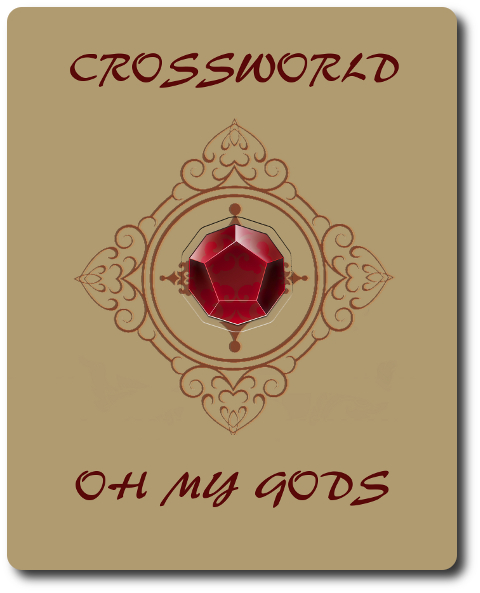
The Basics:
- For ages 8 and up (publisher suggests 12+)
- For 2 or 6 players
- Approximately 45 minutes to complete
Geek Skills:
- Active Listening & Communication
- Counting & Math
- Logical & Critical Decision Making
- Reading
- Strategy & Tactics
- Cooperative & Team Play
- Hand/Resource Management
Learning Curve:
- Child – Moderate
- Adult – Easy
Theme & Narrative:
- When gods collide, the world divides
Endorsements:
- Gamer Geek rejected!
- Parent Geek mixed!
- Child Geek mixed!
Overview
Our world is full of wondrous and terrifying events. The clap of thunder could be the heavy hammer of a god smiting a troll and a fierce storm at sea could be the wrath of the lord of the oceans. The natural world around us plays host to many gods and goddesses who embody our fears and hopes. In this game, they come to life…and then go to war.
Crossworld: Oh My Gods, designed by Zhan Wang and to be published by Smalt Games, will reportedly be comprised of 108 Function cards, 30 God cards, 6 Structure cards, 6 Role cards, and 1 standard six-sided die. As this is a review of a prepublished game, I cannot comment on the game component quality. The illustrations portray the different and unique characteristics of each God and Goddess, making it easy for mortal players to quickly see that the immortals are not to be messed with. Not included with the game, but necessary to play, is some sort of method of keeping track of health values on cards. I suggest small beads or tokens.
Ethereal Battlegrounds
Note: The game set up and game play summarized here is for a 6-player game. The rules for a 2-player game are summarized in the “Game Variant” section.
To set up the game, first shuffle the Role cards and deal 1 to each player, face-down. When completed, reveal the Role cards and match the colors to create 2 teams of 3 players each. Have each team sit across from each other.
Second, shuffle the God cards and deal 3 to each player. After reviewing the God cards, each player selects 1 to use and discards the other 2. The selected God card is placed in front of the player, face-up. The Role card and God card should be placed next to each other at this time.
Third, take the Structure cards and give 1 “Castle and 2 “Tower” Structure cards to each team. The Castle goes in the middle and in front of the “Lord” Role card. The Towers go to the left and right of the Castle and in front of the “Guardian” and “Warrior” Role cards
Fourth, shuffle the Function cards and deal 4 to each player, face-down. Deal the cards in a specific order based on the Role cards.
- Blue Lord
- Red Lord
- Blue Guardian
- Red Guardian
- Blue Warrior
- Red Warrior
Set the remaining Function cards in the middle of the playing area, face-down, and begin.
About the Cards
The game has several different types of cards. Each type is summarized here.
Function Cards
The most numerous in the game, the Function cards are used by all players and found in the draw deck as well as the players’ hands. Function cards provide different actions. These include “Slash”, “Block”, “Cure”, “Strategy”, “Equipment” and “Secret”.
Slash
Allows the player to launch an attack on an opponent’s God card for 1 damage. Only 1 “Slash” Function card can be used by the player on their turn unless another card says otherwise.
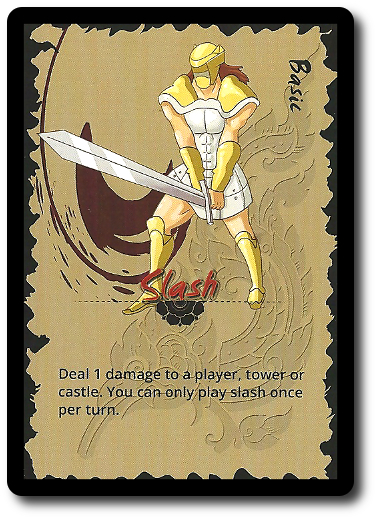
Block
Blocks a “Slash” Function card. The “Block” Function card can only be played by the player to interrupt attacks specifically targeting them unless another card says otherwise.

Cure
Removes 1 point of damage from the player’s God card or from one of their team member’s God cards. Cure cannot rebuild or repair Structure cards.
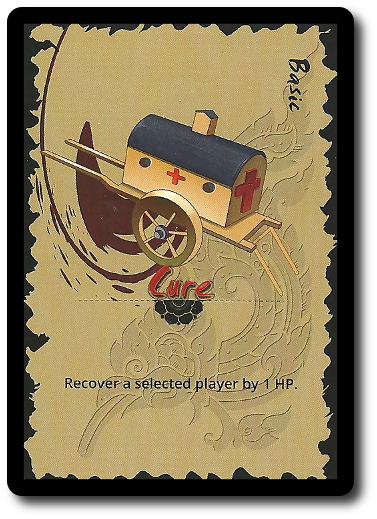
Strategy
“Strategy” Function cards provide a one-time ability that can be utilized by the player and the player’s team to gain an advantage. When to use them and how is up to the player.
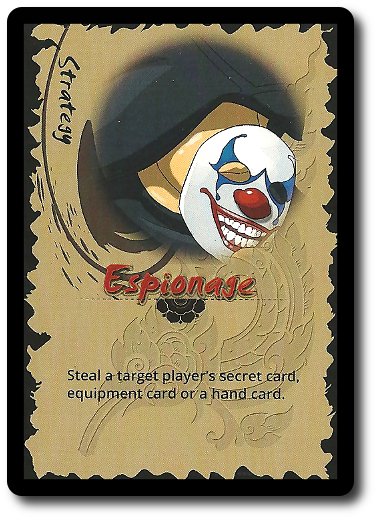
Equipment
“Equipment” Function cards provide the player’s God card with weapons and helpful items. Each God card can use 1 weapon and 1 item card, but the player can re-equip their God card during the game by dropping unneeded equipment and attaching new ones. Dropped “Equipment” Function cards are destroyed (removed from game).
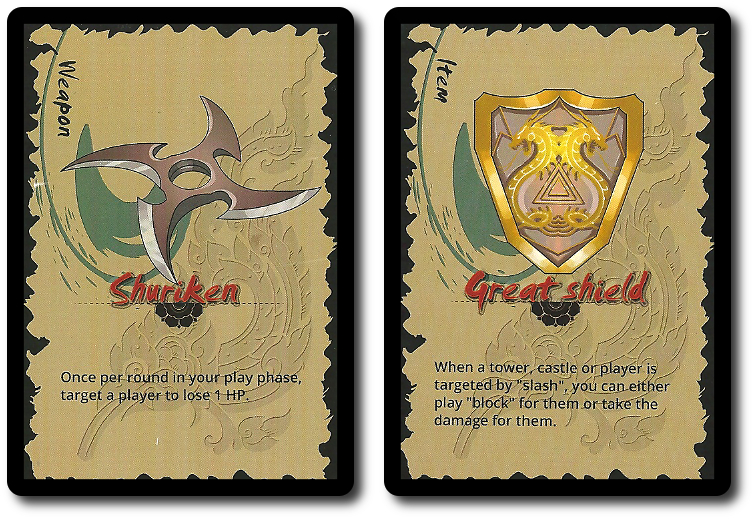
Secret
“Secret” Function cards are like traps. They are played face-down by the player and do not trigger until certain conditions are met during the game. It’s up to the player to remember what triggers the “Secret” Function card. If they forget to do so, the “Secret” Function card is destroyed. Likewise, if a new “Secret” Function card is put into play while another “Secret” Function card is in play, the older card is destroyed. Once the trigger occurs, the “Secret” Function card is revealed by the player and the effects are immediately resolved.
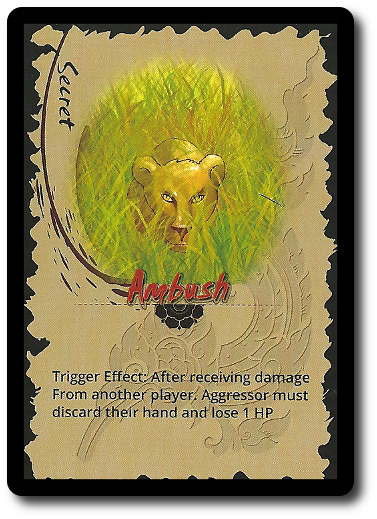
Role Cards
The Role cards are used to determine which players are on which team (red or blue team) and to identify the different roles of the God cards during the game play. Roles define the God card’s primary responsibility in the game, but do not limit them. Depending on the role, each player is given 1 special ability that they can activate once per turn.
The Lord
The “Lord” Role card gives the player the ability to draw 1 Function card per the player’s turn and give it to any ally. Very handy when a team’s fortress is being attacked and certain areas need additional reinforcement.
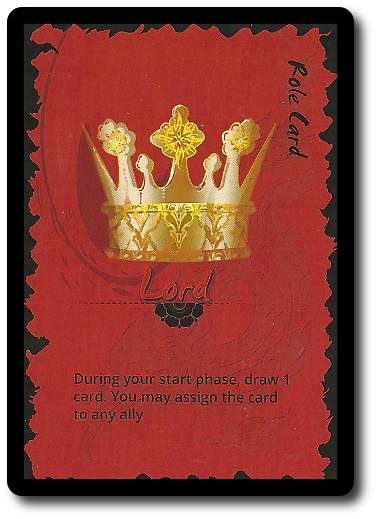
The Guardian
The “Guardian” Role card gives the player the ability to act as a combat medic. Once per round, the Guardian player can play any cards from their hand like they were a “Cure” Function card, helping an ally recover from wounds.
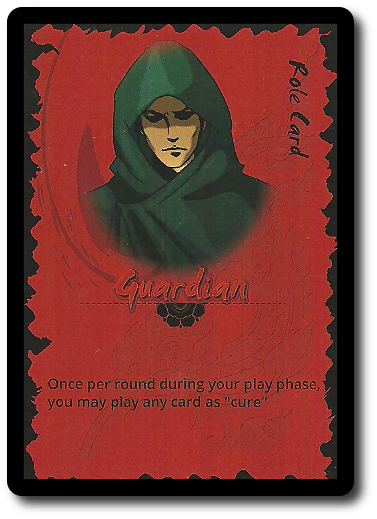
The Warrior
The “Warrior” Role card gives the player the ability to be as aggressive as they like during the game. Once per round, the Warrior player can play any card as a “Slash” Function card, taking the fight to the enemy again and again.
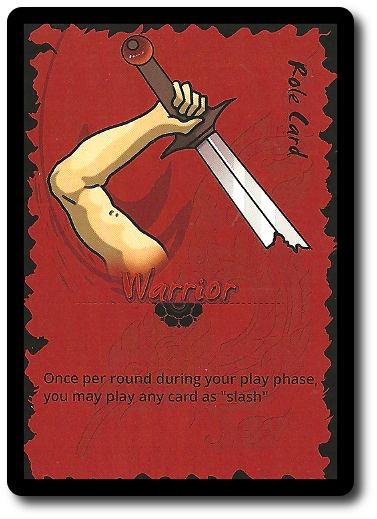
Structure Cards
Structure cards represent the fortress owned and protected by the team. Each team’s fortress is comprised of 2 “Tower” Structure cards and 1 “Castle” Structure card. In addition to each Structure card having its own unique ability, they can also take damage. The total damage (and overall health) of the structure is noted by the number of red gems it has. Once a Structure card takes enough damage (reducing its gems to zero), it’s destroyed. If a team’s fortress should fall, they will lose the game.
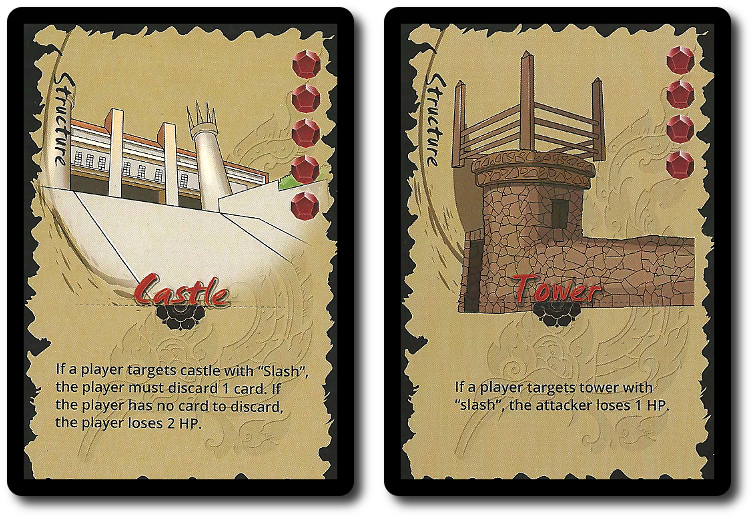
God Cards
The God cards represent the different immortal characters in the game, as well as legendary personalities who have obtained god-like status. Each player will command 1 God card each and be able to access its special abilities. Like the Structure cards, the God cards can take damage and be the target of attacks. None of the God cards are created equal. The stronger they are, the fewer abilities they have access to. As such, a player will need to decide if they want a powerful God card that can take a lot of damage, but provides little in the way of special abilities or a weaker God card who has a wealth of special abilities at their disposal. Further complicating the selection of a God, each is adept in a special area. Specifically, as an aggressor, a manipulator, a supporter, or as a strategist. Picking a God card is much like selecting which kind of gun you want to take with you to war.
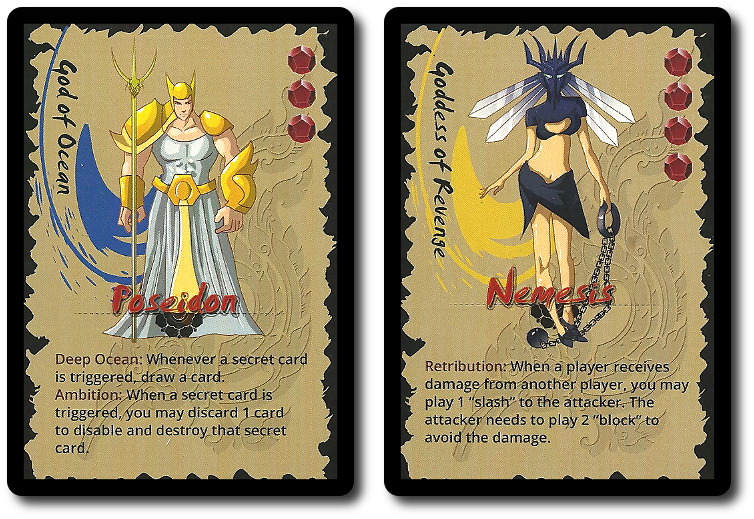
War of the Gods (and Goddesses)
Crossword: Oh My Gods is played in turns and phases. The turn order is determined by the Role cards and is identical to the order in which Function cards were dealt during the game set up. A player’s turn is summarized here. Players should pay special attention to their cards, since many can only be played during specific phases.
Start Phase
This is nothing more than an initial phase of the player’s turn. No actions can be taken here unless the player has a card that can only be activated during the start phase.
Draw Phase
By default, a player will draw 2 cards from the Function draw deck. This number, however, will change during the course of the game. Drawn cards are added to the player’s hand. If there are no more cards left in the draw deck, shuffle the discard pile to form a new draw deck.
Play Phase
Unless restricted, the player can play as many cards from their hand as they now like, targeting foes and destroying enemy structures. The only common restriction is the “Slash” Function card, which can only be played once per player’s turn. Played cards, unless otherwise noted, are placed in the Function card discard pile.
Discard Phase
The number of cards the player can keep in their hand from turn to turn is directly proportional to their God card’s current health. For example, if their God card has 3 health, the player can keep 3 cards. What cards the player keeps and discards is up to them, but the total number of cards in their hand at the end of this phase must be equal to or lesser than their God card’s current health.
End Phase
Like the Start Phase, the End Phase is little more than a chapter in their player’s campaign. Nothing of value will occur during this phase unless the player has a card that can be activated at this time.
This completes the player’s turn. The next player in the Role turn order sequence now takes their turn using the same phases noted above.
Castles, Combat, and Cures
Organized combat is at the heart of Crossworld: Oh My Gods. The main goal is to destroy an opponent’s “Castle” Structure card and to protect your own. How teams go about that is up to them. It could be done by continuing to attack the same structure until it falls or through more subtle means where an enemy’s fortress begins to crumble from within. In either case, there is an incentive to keep structures as intact as possible. To help players keep track of the currents state of their structures, the “Tower” and “Castle” Structure cards have a health value. Reduce it to zero and the structure falls.
Which is not a good thing. The number of “Tower” Structure cards in play on a team’s side is directly proportional to the number of player’s God cards who are still fighting. By destroying enemy towers, the players get to draw additional Function cards, strengthening their cause. Once an enemy God card is back in play, the Tower can then be defended, it if not destroyed.
The “Castle” Structure card can only be targeted if at least 1 enemy God card is down and at least 1 of the enemy “Tower” Structure cards has fallen.
If the player should begin their turn without any health left on their God card or their God card loses all their health during the player’s turn, they are considered injured. A player must play a “Cure” Function card or receive healing during their turn in order to continue. Asking for help from an ally (from the Guardian, for example), is perfectly legal, as is healing the God card out of turn. Failure to heal wounds puts the player and their god/goddess out of commission for 2 turns. On their third turn, they return with 1 health. Gods and Goddesses are impossible to kill, but they can certainly be slowed down. More importantly, a fallen god cannot protect a standing tower or castle.
The very first player to cause an opponent’s God card to drop out of the game is said to have drawn “First Blood” and draws 1 Function card as a reward. In addition, once a god or goddess does fall, all the players on the opposing team draws 1 Function card, too, adding it to their hand.
Healing is very important, obviously, as it keeps not only a team’s Structures in place, but also reduces the negative effects of losing in combat. If a team should lose a player, the next 2 rounds will feel like they are attacking and defending with one arm behind their back. Communication is key, as it allows the team to keep in sync, understand where they should keep focus and maintain a continues understanding of their own state of affairs.
The End of All Wars
The game ends when a team’s “Castle” Structure card is destroyed.
Game Variants
The game can be played with 2 players, which is referred to as “Commander Mode”. The game’s objective is the same, with only a few slight adjustments to the overall game play and set up. Each player will lead 3 God cards instead of only 1 and the number of Function cards available to each player is increased, as well. This game variant was very popular with the players who enjoyed the game, but not the cooperative aspect.
To learn more about Crossworld: Oh My Gods, visit the publisher’s website or visit the Kickstarter campaign.
Final Word
The older Child Geeks grasped the game’s concept and rules fairly easily, but the younger Child Geeks struggled. The game’s rules are not overly complicated and the card text is straightforward in most cases, explaining what can and cannot be done. Where the younger Child Geeks had problems was knowing what to use and for what effect. As one younger Child Geek put it, “All I want to do is attack that player, but I cannot figure out how to go about doing it with my cards.” This frustrated many younger Child Geeks and it also made a few older Child Geeks a bit cross, as well. As one older Child Geek put it, “I don’t think the game is all that hard, but you sometimes just don’t have the cards and you have to depend too much on other team members to help out. I know we are supposed to work as a team, but I sometimes feel like I am holding everyone back.” To be clear, there is no such thing as a “bad card” in the game, but it can be difficult to coordinate with other players. Especially when they don’t understand how best to use the cards they have. Oddly enough, the older Child Geeks found the 2-player game much more enjoyable. When the games were over and the battles fought, the Child Geeks were split on their endorsement. The older Child Geeks liked the game well enough to approve it, while the younger Child Geeks did not.
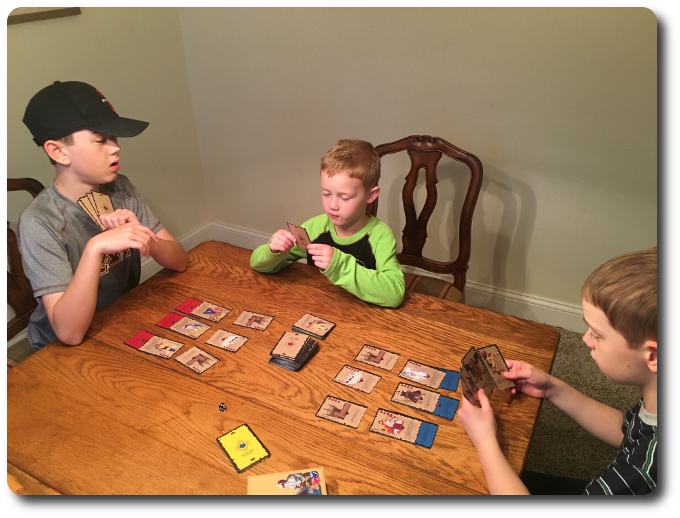
After having played with a team, a number of the Child Geeks decided to go solo as their own commander
The Parent Geeks had no issues learning and playing the game, but it was clear that not everyone was enjoying it. According to one Parent Geek, “The game is fine, I suppose, but I’m not finding it very exciting. It feels like I’m just trading hit after hit until someone screams uncle.” But that was not the case for all the Parent Geeks. One very enthusiastic player said, “It’s a fun game, where you really have to work as a team. The best part is dropping a secret ambush and having your opponents spring it! The look on their faces is priceless.” There are a number of tricks players can employee to bring confusion and misery to their opponents, but it must be timed and executed as a team. This was not lost on the Parent Geeks, but only appreciated by the more skilled players. When the votes came in, the casual and non-gamer Parent Geeks decided not to approve the game, while the more strategic and skilled Parent Geeks were happy to play the game again and again.
The Game Geeks didn’t appreciate the game. According to one Gamer Geek, “The game has the right idea, but doesn’t go about it the right way. All of my strategy and tactics is based on cards which I am dealt randomly and have to use or lose.” The Gamer Geeks decided to look at the game another way, focusing on the team play aspect. Again, they felt the game had come up short. As one Gamer Geek put it, “The players can interact, using their abilities, roles, and cards, but the interaction is limited. I didn’t feel like I was working as a team so much as playing a game with other players who shared my same goal.” Which wasn’t considered bad by the Gamer Geeks, but they recognized this was not the game’s intent. When all the games were over, the Gamer Geeks agreed that Crossworld: Oh My Gods had some good ideas, but didn’t feel like a game that was trying to connect the players together as a team. They liked the 2-player experience, but would not approve or reject a game based on its game variant. The end result was a soft rejection from the Gamer Geeks.
Crossworld: Oh My Gods is not an easy game if you are playing against opponents who are really watching their borders or you don’t have the right cards. However, I don’t agree with some of our players who suggested they didn’t have the right cards to do what they wanted to do. I have yet to play the game and not have cards in my hand that felt useful. Yes, they may not be the cards I want, but they are certainly cards I can do something with. This is what a number of our players failed to grasped. Crossworld: Oh My Gods is not so much about what you can do in 5 turns, but what you can do right now and in the next turn and in the next turn to move closer to your goal. The battlefield is a chaotic place, after all, so the best approach to victory is baby steps and taking advantage of sudden soft spots defenses.
I do agree with some of our players that stated the game doesn’t feel like much of a cooperative experience. Nowhere in the rules does it state that the players can or cannot share cards or discuss strategy. Depending on how you interpret that, players will either work in a mutual vacuum or constantly suggest what cards should be played. Both styles work because players spend a great deal of their time piggybacking off their ally’s and opponent’s cards, either as a reaction or as a follow-up action. This is why the game works so well with only 2-players. Team work comes in the form of cards played and reinforcing previous plays or setting up future plays. While not overly subtle, this type of game play is not readily apparent to players until they start to see how cards and players interact.
I found the game to be OK, but not spectacular. The only surprises you have are the cards you draw and the casual Secret card that is played in front of you. Everything else is focused on tearing down towers, harming God cards, and taking pot shots at the enemy’s “Castle” Structure card. And that’s it. You cannot formulate a strategy since cards are always shifting, which leaves the full focus of the game on tactics. Which can be a lot of fun if you have like-minded players. Otherwise, the game becomes little more than an exercise of actions and reactions. The game can drag on way too long if such is the case.
Overall, not a bad game, but not one for those who are looking for obvious inroads to victory. You’ll spend a great deal of your time whittling down defenses and shoring up your own, all the while attempting to determine how best to use cards and abilities for maximum effect. The many God cards provided give the game a lot of replayability and interactive tactical plans to develop. It’s a new take on an old idea of storming the castle that works, but might not feel comfortable to players who need signpost to help guide them. If Crossworld: Oh My Gods sounds like an interesting game to you, then do try it. It’s easy to learn, but will challenge even the most skilled player when it comes time to charge the castle walls.
This is a paid for review of the game’s final prototype. Although our time and focus was financially compensated, our words are our own. We’d need at least 10 million dollars before we started saying what other people wanted. Such is the statuesque and legendary integrity of Father Geek which cannot be bought except by those who own their own private islands and small countries.



